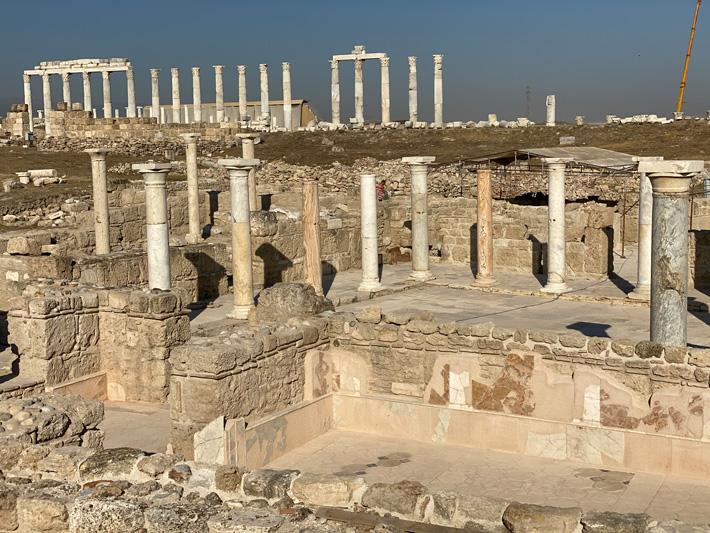Early Christian Church Unearthed in Turkey
A building featuring 20 columned corridors arranged around a courtyard has been discovered next to a theatre in southwestern Turkey’s ancient city of Laodicea, according to a Hurriyet Daily News report. Celal Şimşek of Pamukkale University said the structure was used as a home, as a place of business, and as a Christian church.
In Laodicea, the largest ancient city in Anatolia after Ephesus, excavations have been ongoing for a year. So far, a church, theatre and two streets called Syria and Stadium with their columns have been revived.
Besides, many important structures such as the 1,750-year-old travertine blocks with frescoes, which were destroyed in the earthquake that occurred in 494 A.D., a three-meter-long statue of the 1,906-year-old Roman Emperor Marcus Ulpius Nerva Trajan and the sacred agora have also been discovered. Three graffiti engraved on a marble block, estimated to be 1,500 years old, have also been found.
In Laodicea, which was a metropolitan city in ancient times and was home to one of the seven churches mentioned in the Bible, a church was unearthed inside a house, located adjacent to the northern theatre.
Speaking to the state-run Anadolu Agency, Şimşek said that works have been continuing to revive the Hellenistic era’s 2,200-year-old theatre, which was found in the recent years in the west, and the peristylium (a courtyard surrounded by open columned corridors) with the church inside.
Şimşek stated that the house, which is estimated to be about 2,000 years old and built on an area of 2,000 square meters, is located in a very interesting place.
“Here, we know that the house was used as of the first century A.D. and that the main planning system of the Roman Empire period continued intact until the seventh century A.D. We obtained interesting results in our works in the house.
We saw in the house the fault lines of the earthquakes that destroyed Laodicea over the years. We are working here by protecting these fault lines.”
Şimşek explained that with the spread of Christianity, the first believers had secretly transformed some parts of this large house into a place of worship.
Noting that there are two separate architectural halls for men and women in the house, He said, “The hall in the west was organized for men and the one in the east for women and a place of worship was made here in east hall.”
“In the middle of the house, there is a hall with 18 columns. In this house, we found baths, shelters and other sections that were used as business places. The direction of the secret church in the house was facing north,” Şimşek added.

Noting that they unearthed very rich marble coverings on the walls of the eastern hall, which was converted into a church, Şimşek stated that they were able to see how believers of Christianity worshipped here.
Emphasizing that the house is very special and unique, he said, “It is the only example in the regard that this place was used as both a home and a business place and is adjacent to the theatre.”
Stating that during the excavations, they also unearthed the sacred items used by the first Christians, Şimşek said, “We think that the Laodicea Church was built after Christianity was made free, and the high-ranking clergy there probably lived in this house, but we have not yet made a clear determination regarding this.”
“This house with the church is very important in terms of reaching data on how Christianity spread in Laodicea since the middle of the first century A.D.,” he added.
